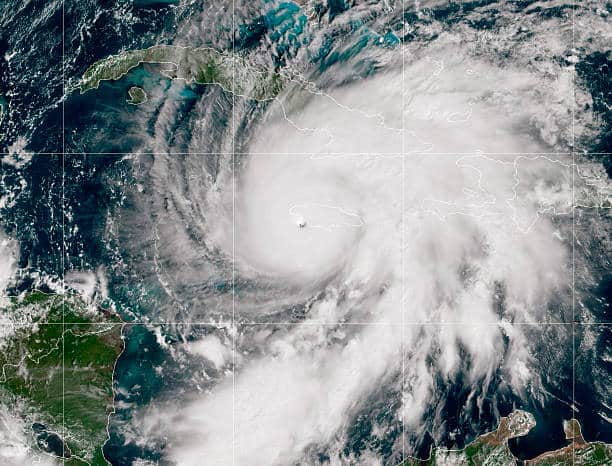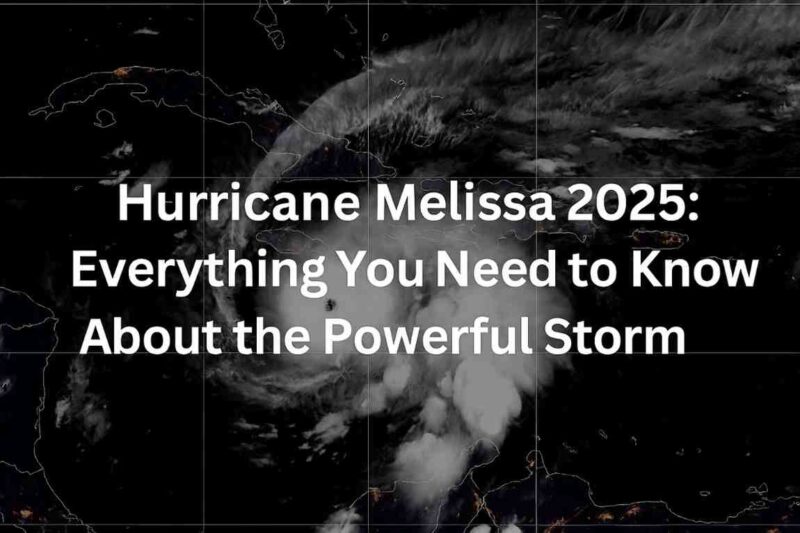Hurricane Melissa made landfall in Jamaica on October 28, 2025, as a Category 5 hurricane with maximum sustained winds of 185 mph and considerably greater gusts, according to the National Oceanic and Atmospheric Administration (NOAA). After reaching the Caribbean island, the cyclone fell to Category 4, with sustained winds of 145 mph.
The hurricane poses a severe threat to millions of people in the Caribbean, particularly in Jamaica, Haiti, Cuba, the Bahamas, and the Turks & Caicos Islands. Residents are at risk of catastrophic wind damage, severe flooding, and landslides.
What Is Hurricane Melissa 2025?


Hurricane Melissa is currently a powerful Atlantic hurricane making landfall in Cuba. Melissa, the thirteenth named storm, fifth hurricane, fourth major hurricane, and third Category 5 hurricane of the 2025 Atlantic hurricane season, developed from a tropical wave that was first tracked on October 16, 2025.
The wave originated in West Africa, travelled from the central Atlantic to the Windward Islands, and then raced westward into the Caribbean Sea, where it slowed and formed Tropical Storm Melissa on October 21.
Melissa remained wandering and disorganized over several days as it slowly travelled northwest due to weak steering currents and strong wind shear. Melissa got more organised over time, and from October 25 to 27, it swiftly strengthened into a Category 5 storm before making landfall near New Hope, Jamaica, on October 28.
How Melissa became a Category 5 monster
Tropical Storm Melissa formed on Tuesday and rapidly strengthened as it headed westward through the Caribbean.
A hurricane arises when warm, moist air rises from the ocean’s surface, causing a spinning system of clouds and storms. In the centre, air lowers, forming the eye, a tranquil, cloud-free zone surrounded by a wall of severe winds and rain known as the eye-wall.
Melissa’s story begins in mid-October, with a cluster of thunderstorms off the coast of West Africa. By October 21, it had reached tropical storm status, and by October 26, it was a Category 4 hurricane raging through the Caribbean Sea.
This year’s ocean temperatures in the Caribbean have been extremely high, and storms feed on that warm layer of water. Melissa’s intensity increased rapidly under these conditions.
Low pressure and violent winds
Melissa is one of the strongest storms in the Atlantic this century. For Jamaicans, the similarities to previous storms are terrifying. If it strikes Jamaica at close to full strength, it has the potential to outperform all previous storms. Gilbert was the last direct hit in 1988, with a Category 3 rating. It levelled thousands of homes and killed 49 individuals. Dean in 2007 and Beryl in 2024 came close, but neither could equal Melissa’s strength.
As of the National Hurricane Center’s advisory on Tuesday morning local time, the storm’s core air pressure had dropped to 892 millibars, lower than Hurricane Katrina’s 902 mb. The lower the pressure, the stronger the winds, making this one of the most powerful systems to form in the Atlantic.
Hurricane Katrina, which slammed New Orleans in 2005, killed 1,392 people and inflicted an estimated $125 billion in damage. The storm has claimed four lives in Haiti and the Dominican Republic. Jamaica’s Ministry of Health confirmed on Monday that three individuals died on the island while preparing for the approaching storm.
Melissa grew especially swiftly because of the Caribbean’s extremely warm waters, which were one to two degrees above usual.
Slow pace poses catastrophic flooding risk
While the wind speed is incredible, the storm’s pace is noticeably slow. Melissa was moving westward at about 5 km/h on Tuesday, which is slower than a person’s strolling pace.
Meteorologists warn that this laziness might have disastrous consequences because a hurricane can dump rain on a single region for days on end, exacerbating flooding. When hurricanes stall, they remain over one location for far longer than usual, causing repeated waves of rain, floods, and wind damage.
One of the most well-known examples of this is Hurricane Harvey, which stalled over Houston, Texas, in 2017. Harvey dumped 100cm of rain in just three days, resulting in devastating floods.
The US National Hurricane Centre has warned that Jamaica could receive 38 to 76 cm of rain, wHurricNith up to a metre in some hilly places. Storm surges of up to four metres are likely, particularly along the island’s south and east coasts. Low-lying parishes like Clarendon and St Catherine are vulnerable to flash floods caused by both rainfall and torrents from the Blue Mountains.
According to some study, hurricanes are moving more slowly than in the past. This means that more storms like Melissa can sit rather than sweep across the land they hit. Some scientists believe this is due to how climate change is influencing circulation patterns in our atmosphere, although this is not definite, and natural variability may also play a role.
How Melissa Turned Deadly in Haiti, Dominican Republic
As of Saturday afternoon, Melissa had been blamed for at least four deaths in Haiti and the Dominican Republic. Conditions are forecast to deteriorate significantly in the following days as the storm develops power, bringing further rain, wind, and storm surge to the Caribbean.
This storm is expected to gradually travel northwest across a part of the Western Caribbean into early this week. By late Monday, Melissa’s route will be impacted by the jet stream’s larger-scale structure, allowing it to curve northward and rocket northeastward as the week progresses, producing multiple landfalls in the northern Caribbean.
Melissa strengthened to a Category 5 hurricane (maximum sustained winds of 157 mph or greater) early Monday morning prior to its approach along the southern coastline of Jamaica.
What rapid intensification will mean for Jamaica?
Melissa progressively drifted northward towards Jamaica, crossing over some of the warmest seas in the Western Atlantic, which contributed to the storm’s strengthening. Melissa quickly grew from a tropical storm to a major hurricane in approximately 9 hours on Saturday. Melissa is projected to make landfall as a Category 5 hurricane around 7 a.m. Tuesday, Oct. 28, EDT, along Jamaica’s southern shore, roughly 60 miles west of Kingston.
Norman Manley International Airport, located near Kingston Harbour on Jamaica’s southeastern coast, is connected to the island via a brief piece of highway. Given the current landfall location and the storm’s expected intensity, this roadway is at a high risk of destruction of the storm in the coming days.
Melissa to carve a path through the northern Caribbean
Across the western Caribbean, the AccuWeather RealImpact™ Scale for Hurricanes is 5, the largest value possible. AccuWeather analysts designed this scale to assess the risk to life, property, and economic damages from the storm, which include flooding, rain, storm surge, and severe winds. The Saffir-Simpson Hurricane Wind Scale solely considers a storm’s maximum winds.
Cities and communities around Cuba’s southeastern edge are being warned to make final preparations as quickly as possible as Melissa approaches with wind, rain, and a dangerous storm surge along the shore. Rainfall totals are expected to range between 12 and 18 inches across this Cuban corridor, potentially causing disastrous infrastructure damage, road washouts, and mudslides across the varied terrain.
As the storm’s position in the western Caribbean slows, the region will experience heavy and widespread rainfall for several days.
States and Countries at Risk: Who Should Prepare for Hurricane Melissa?
Melissa is likely to remain a dangerous storm when it moves past areas of the Bahamas this week. By this stage, however, it should have gained some forward momentum and been drawn out of the Caribbean and into the open waters of the Atlantic.
However, Melissa is forecast to approach Bermuda close enough to have damage in the future. Melissa is expected to move closer to the East Coast of the United States when it exits the Caribbean, with substantial indirect consequences expected during the last days of October and the first days of November, thanks to the jet stream and a non-tropical storm.
How to Protect Your Home and Family During Hurricane Melissa
Several organisations have taken the initiative to begin distributing relief to individuals affected by the storm. Here are several organisations working to help hurricane victims.
Airlink
Despite widespread airport closures, Airlink is working with partners such as American Airlines and United Airlines to quickly bring relief and rescuers to Jamaica. Donations can be made in cash, frequent flyer miles, or cryptocurrency.
American Friends of Jamaica.
The organization’s Disaster Relief Fund provides crucial assistance to communities in Jamaica hit by natural or humanitarian calamities. Its board of directors has agreed to match donations of up to $1 million.
The American Red Cross
Red Cross officials confirmed that their chapters on the islands, as well as the International Federation of Red Cross and Red Crescent Societies (IFRC), are fully operational and working together to respond throughout the possibly affected countries.
Americares
This health-focused non-profit said it is preparing to send an emergency response team to Jamaica and has an emergency medical team ready to give primary care to survivors if necessary. Americares has also provided aid to partner organisations in Haiti and the Dominican Republic.
CORE (Community Organized Relief Effort)
CORE, which has previously responded to storms in the Caribbean, has deployed air cargo ships carrying hygiene kits, tarps, and other relief supplies to Jamaica and is prepared to send resources to Haiti.
Direct Relief
In response to Hurricane Melissa, officials said that they have committed an initial $250,000 in financial help and have made their complete medical inventory available to Caribbean health providers.
Footprint Project
This non-profit is ready to deploy over 150 portable solar and battery power stations in Jamaica, as well as mobile microgrid equipment from Puerto Rico and Barbados. The organisation is accepting cash and equipment donations, including turn-key renewable power, water, and shelter innovations that can be shipped quickly. To coordinate equipment donations, contact [email protected].
United Way
United Way is collaborating with partners to offer food, water, and shelter for individuals affected by Hurricane Melissa in the Caribbean. You can give here to help with immediate assistance and long-term healing.
World Central Kitchen
World Central Kitchen stated in a statement that it was in Jamaica ahead of the storm and was “working with local partners to begin serving meals as quickly as possible to families impacted by the storm.” Donations to the nonprofit organisation can be made here.
Conclusion
Over the weekend, Hurricane Melissa intensified extremely rapidly. “Its intensity has increased by 50 kt over the past 24 hours and 35 kt over the past 12 hours,” the National Hurricane Centre reported on Sunday morning. As a reference, 50 kt is equivalent to 57.5 mph, while rapid intensification is defined as increasing maximum wind speed by 35 mph in less than 24 hours. Melissa achieved 40 mph of maximum wind speed in half the time.
NHC predicts that life-threatening flash flooding and landslides in southwestern Haiti and the Dominican Republic may cause isolation and infrastructure damage. Eastern Cuba, Turks and Caicos, and the southern Bahamas will need to keep an eye on Melissa. It will most likely become a hurricane once it crosses Jamaica.








